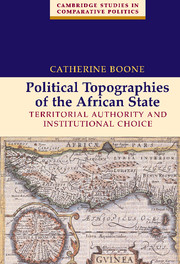Book contents
- Frontmatter
- Contents
- List of Maps, Tables, and Figures
- Preface and Acknowledgments
- 1 INTRODUCTION
- 2 MAPPING POLITICAL TOPOGRAPHY IN AFRICA
- 3 UNEVEN INSTITUTIONAL TOPOGRAPHY WITHIN ONE STATE
- 4 TAXING RICH PEASANTS: REGIME IDEOLOGY AS STRATEGY
- 5 THE GEOPOLITICS OF LATE DEVELOPMENT
- 6 CONCLUSION
- Appendix: A Note on Sources, Evidence, and Measurement
- References
- Index
- Cambridge Studies in Comparative Politics
3 - UNEVEN INSTITUTIONAL TOPOGRAPHY WITHIN ONE STATE
Published online by Cambridge University Press: 26 December 2009
- Frontmatter
- Contents
- List of Maps, Tables, and Figures
- Preface and Acknowledgments
- 1 INTRODUCTION
- 2 MAPPING POLITICAL TOPOGRAPHY IN AFRICA
- 3 UNEVEN INSTITUTIONAL TOPOGRAPHY WITHIN ONE STATE
- 4 TAXING RICH PEASANTS: REGIME IDEOLOGY AS STRATEGY
- 5 THE GEOPOLITICS OF LATE DEVELOPMENT
- 6 CONCLUSION
- Appendix: A Note on Sources, Evidence, and Measurement
- References
- Index
- Cambridge Studies in Comparative Politics
Summary
Institutions that project state power into rural Africa distribute political and administrative authority between central and local elites. This chapter traces this institutional topography in Senegal and reveals a political landscape marked by striking geographic variation. This variation has virtually no basis in legal text and goes largely unnoticed in studies that generalize from findings from the groundnut basin, Senegal's export-producing core. The unevenness is an artifact of the periphery's ability to shape the choices of institution builders at the center.
A conventional wisdom holds that postcolonial African states are so centralized and bureaucratic, and African rulers so heavy handed in their dealings with the countryside, that significant regional variations in state structure and process have not been allowed to develop. Postcolonial Senegal is often depicted in these terms. It is often presented as the archetype of the overcentralized, bureaucratic state. In Wunch and Owolu's Failure of the Centralized State (1990), the Senegalese government is described as driven by a passion for territorial administrative uniformity and top-down control. These excesses are said to reflect the modernizing instincts of the nationalist elite, the heavy imprint of French administrative law and tradition, and the legacies of French direct rule.
Centralizing impulses have indeed been ever present, and accounts that stress this must be taken seriously in an African country with a history of administrative continuity and political stability as long as Senegal's.
- Type
- Chapter
- Information
- Political Topographies of the African StateTerritorial Authority and Institutional Choice, pp. 43 - 140Publisher: Cambridge University PressPrint publication year: 2003

